
table of contents
- Wild bushes for natural gardens from A to G
- From H to L
- From P to S
- Wild shrubs for natural gardens with W
- frequently asked Questions
Wild shrubs are an important design element for natural gardens. Different types and their needs are presented here. They are also suitable for planting a hedge, which is suitable, for example, as a breeding ground for birds.
In a nutshell
- Natural gardens are nesting places, food and hiding places for many animals
- most have thorns, some are poisonous
- Wild shrubs are often less demanding than cultivated plants
- they have attractive foliage, flowers and fruits
Wild bushes for natural gardens from A to G
Chokeberry (aronia) - edible
The chokeberry is often grafted on trunks, but in the wild it grows as a low shrub. In the natural garden it is suitable as food for birds that like to eat the black berries. In autumn the aronia develops attractive reddish foliage.
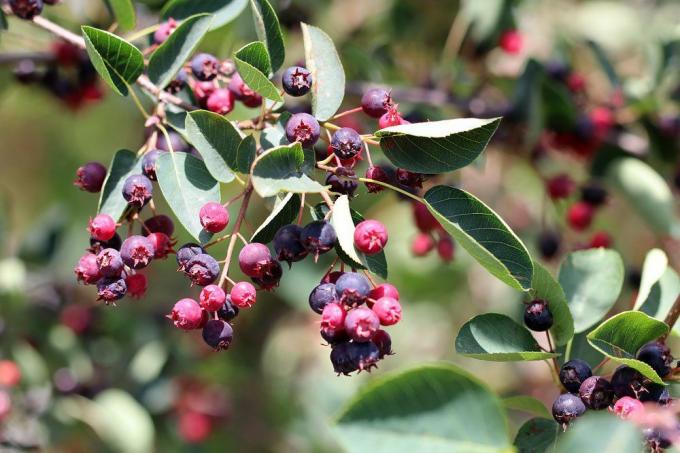
- Size: 1 - 2 m high
- Location: no special requirements, rather sunny
- Flowers: white, late April to May
- Care:
- undemanding, little fertilization and watering
- Propagation via runners or self-sowing
Real Barberry (Berberis vulgaris) - poisonous
The sea buckthorn is the only barberry native to Germany. Since these shrubs are hosts of the grain rust, they have been almost exterminated. With their red berries, they are an attractive addition to natural gardens.
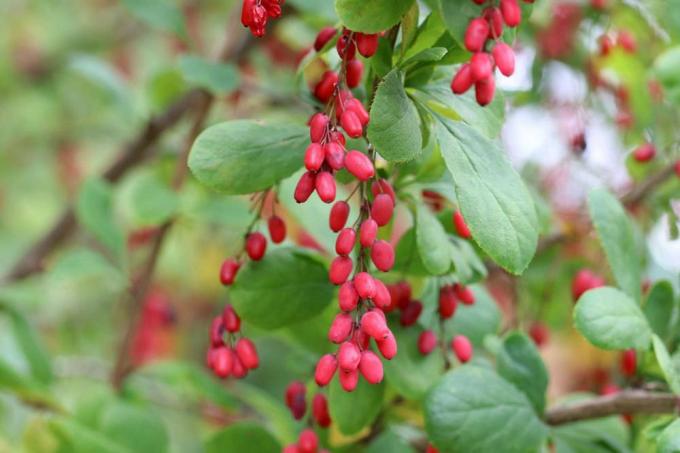
- Size: small to medium-sized shrub
- Location: undemanding in relation to the soil, sunny or partially shaded
- Flower: yellow, May to June
- Care:
- Mulch replaces additional watering and fertilizing
- Propagation via cuttings
Common wolfberry (Lycium barbarum) - edible
These shrubs are also known as goji berries, and the dried berries are available for purchase in organic stores. They are considered a superfood. Planting time is in spring.

- Size: 2 - 4 m in height and width
- Demands: well drained soil, sunny
- Flower: purple, June to August
- Care:
- water in case of dryness
- fertilize with compost in spring
- Propagation via runners
Note: The wolfberry is very likely to spread, if this is not desired, a root barrier must be buried.
Common snowberry (Symphoricarpos albus) - inedible to poisonous
The snowberry is known under the name Knallerbsenstrauch. The plant originally comes from North America and was used as an ornamental shrub in Germany. In the meantime, however, there are also specimens that have gone wild.
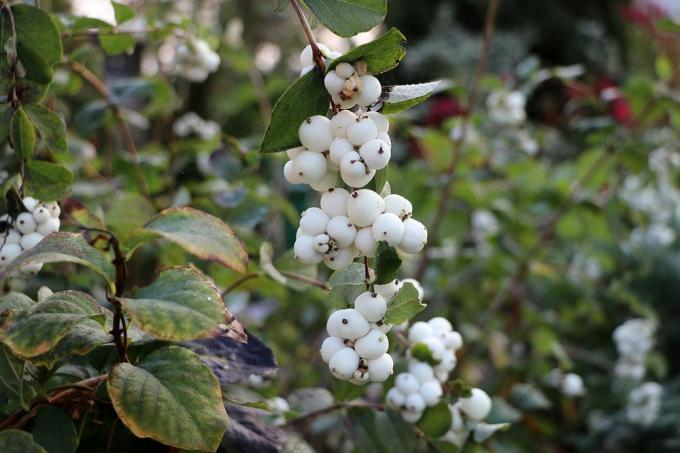
- Size: 1 - 2 m high
- Demands: sunny, otherwise undemanding, does not like waterlogging
- Flowers: white and pink, June to September
- Care:
- No fertilizer or irrigation necessary
- Mulch layer in the root area makes sense
- Propagation via seeds and runners is spread by birds
Gorse (Genista) - poisonous
Gorse species are either shrubs or subshrubs and develop a long taproot, making them difficult to replant later.

- Size: 50 cm to 2 m high
- Location: no waterlogging, as sunny as possible
- Flowers: yellow butterfly flowers, May to July
- Care:
- water and fertilize little
- too much fertilizer puts flowers at a disadvantage compared to leaf growth
- Propagation via seeds and cuttings
From H to L
Dogwood (Cornus) - poisonous
The wild dogwood species in Germany include the cornel and blood-red dogwood.
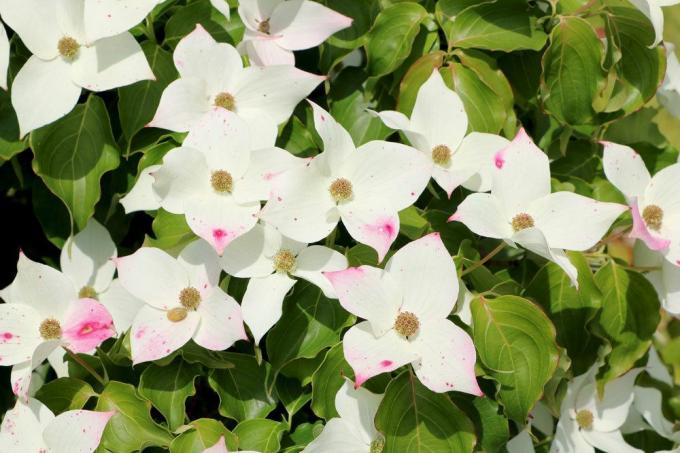
- Size: 1.5 to 5 m tall or small tree (cornel cherry)
- Location: sunny, nutrient-rich soil, preferably loamy
- Flower: yellow, May to July
- Care:
- do not let it dry out, avoid waterlogging
- now and then fertilize, mulch
- Propagation via seeds and cuttings
Note: The blood-red dogwood gets its name from its red shoots. So that you don't have to do without this beautiful color, the shrub is regularly planted on the cane.
Hazelnut bush (Corylus avellana) - edible
There are many cultivars of the hazelnut that are very productive and are more likely to be useful plants. However, the hazel is also justified in natural gardens, as it can be a retreat for a wide variety of animals.
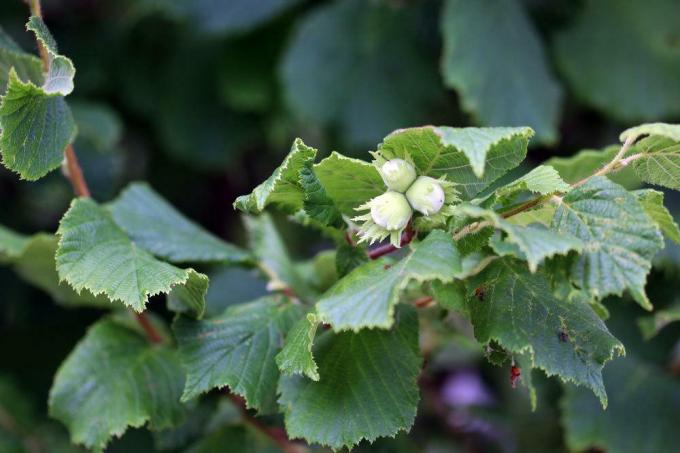
- Size: 5 to 6 m high
- Location: for rich yield humus and nutrient-rich soil, sunny location
- Blossom: inconspicuous, winter and early spring
- Care:
- water in case of prolonged drought
- fertilize with compost in spring
- Propagation by subsidence
Honeysuckle (Lonicera) - poisonous
Several species of the honeysuckle are native to Germany. Including the black and the red honeysuckle. These shrubs are suitable for hedges in natural gardens.

- Size: 1 to 3 m high and wide
- Demands: sunny location, permeable soil, otherwise undemanding
- Blossom: yellowish-white, also a little red in color, May to June
- Care:
- water in case of prolonged drought
- fertilize with organic matter in spring
- Propagation via cuttings
liguster (Ligustrum vulgare) - poisonous
These shrubs are particularly good for hedges. They grow densely and are well tolerated by pruning. Planting time is in autumn or spring.
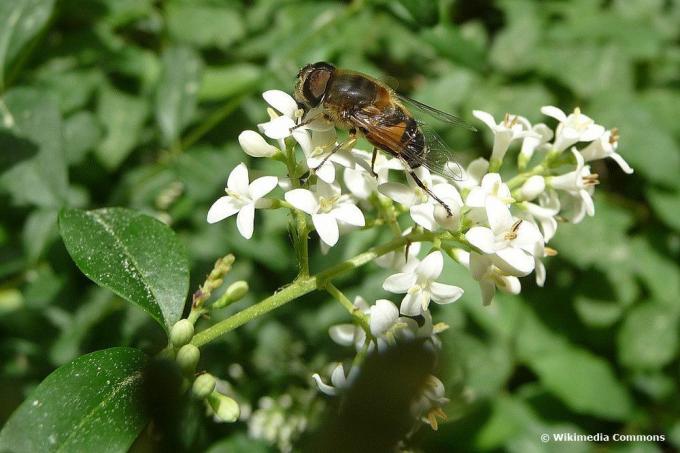
- Size: 1 to 5 m, in hedges depending on the cutting height
- Demands: Hardly any demands on the soil, sunny to partially shaded location
- Flowers: white, June to July
- Care:
- does not have to be watered even in dry conditions
- fertilize organically in spring
- Propagation by self-sowing or cuttings
From P to S
Pfaffenkäppchen,Common euonymus (Euonymus europaeus) - poisonous
The fruits of these shrubs give them their name, they are very conspicuous and brightly red in color. The reddish autumn leaves are just as striking.

- Size: 2 - 6 m high
- Demands: quite undemanding compared to the ground, sunny location
- Flowers: white to yellow, maize to June
- Care:
- easy to care for, water in extremely dry conditions
- Mulching protects the soil area from drying out and supplies nutrients
- Propagation via seeds
Sea buckthorn (Hippophae rhamnoides) - edible
The fruits of the sea buckthorn are known for their high vitamin C content. They are processed into jam or puree. The shrub spreads very aggressively without a root barrier, which should be taken into account when planting.
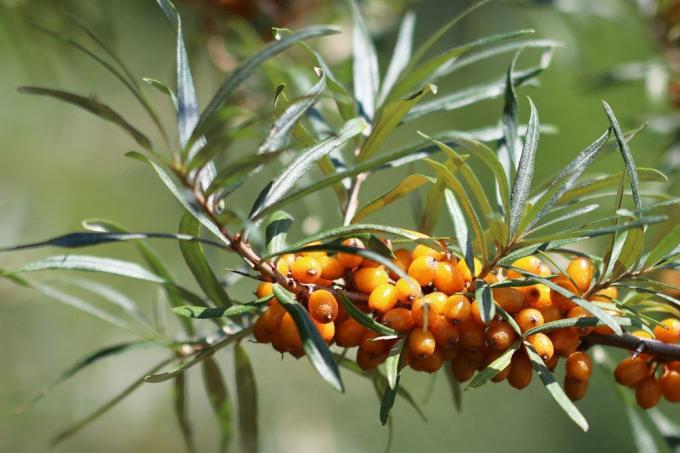
- Size: 4 - 5 m high, a little less wide
- Requirements: sunny, deep soil, not compacted
- Flower: yellow, March to May
- Care:
- for a rich harvest put several females with one male plant
- watering and fertilizing are not necessary
- Propagation via offshoots
Snake berry, common viburnum (Viburnum opulus) - poisonous
The snowball is considered an ornamental shrub, but can also be found wild in Germany and is therefore suitable for natural gardens. The red berries should be edible when ripe, but caution is advised because this opinion is not unanimous.

- Size: 1.5 - 6 m high
- Demands: sunny, but also shady, well-drained, not too dry soil
- Flowers: white, April to June
- Care:
- does not have to be specially fertilized, a layer of mulch in the root area is sufficient
- no watering required
- Propagation via cuttings
Sloe (Prunus spinosa) - edible
These shrubs are also called blackthorn or sour plum. The fruits are edible after the first frost, but should be cooked. In order to prevent uncontrolled spreading, a root barrier must be planned. Planting time is in autumn.
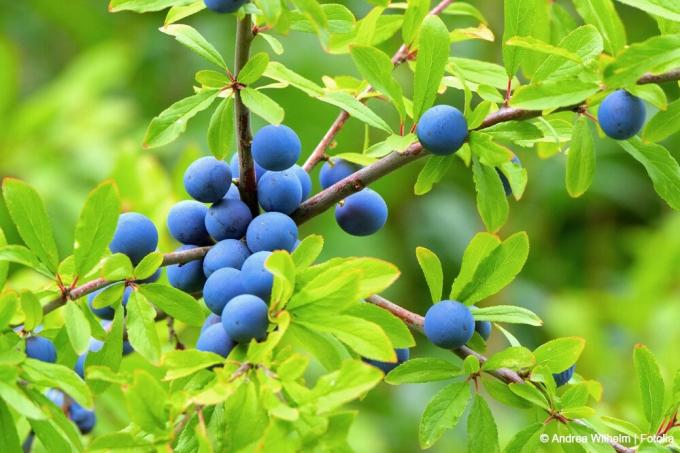
- Size: up to 3 m high, growing strongly in width due to root runners
- Demands: sunny, warm, nutrient-rich soil
- Flowers: white, March to April
- Care:
- does not have to be fertilized or watered
- Propagation via root runners
- too many runners are removed
Black elder (Sambucus nigra) - edible
Many parts of the elderberry plant are poisonous. The berries are also only edible after they have been cooked. The flowers can be made into syrup.
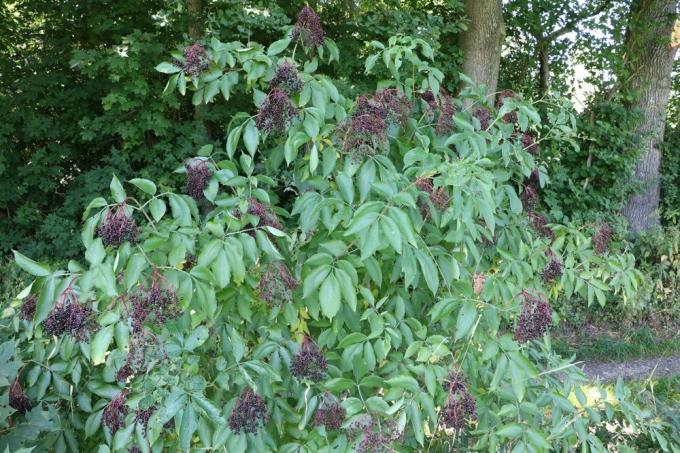
- Size: up to 7 m high
- Demands: mostly sunny, but also shady, nutrient-rich soil
- Flower: white, May
- Care:
- water only when it is dry
- Pruning keeps the shrub young
- Propagated by seeds, spreads quickly by birds
Buddleia (Buddleja) - not edible, but non-toxic
The butterfly lilac is a common ornamental plant that is noticeable because it is very popular with Butterflies is. Besides butterflies, it is also approached by bees and bumblebees. It originally comes from Asia, but is also increasingly feral in Germany. The best time to plant is in spring.

- Size: 1.5 - 4 m high
- Demands: sunny, largely undemanding in terms of the soil
- Flowers: white, pink, purple, from July until frost
- Care:
- fertilization and watering are not necessary
- Winter protection improves winter hardiness
- Propagation by self-sowing or cuttings
Wild shrubs for natural gardens with W
Willow (Salix) - not edible, but non-toxic
Willows are mostly trees, but there are also small species that grow like a bush. They are very fast-growing and are well suited for design purposes in natural gardens. In this way, small arbors can be easily "built" from living willow. Pastures are very early bee pastures.
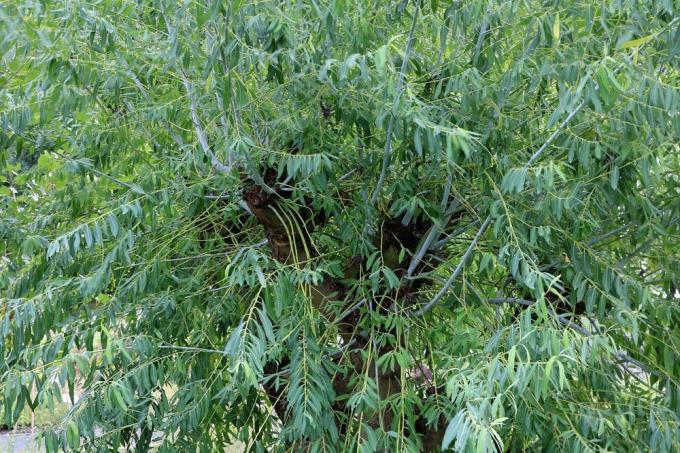
- Size: several meters
- Demands: adaptable, soil not too dry
- Flowers: greenish colored catkins on female, yellowish on male, from March
- Care:
- water in case of drought
- fertilize annually in spring
- Propagation via cuttings
Hawthorn (Crataegus) - edible
In Germany the single and double flute hawthorn are native. The berries are edible, even raw, and are often made into jam or compote. If the fruits are not harvested, birds will be happy to eat them. The red-backed shrike uses the long thorns to spear captured food animals.

- Size: 5 - 7 m high
- Demands: any type of soil is tolerated, a sunny location preferred
- Flowers: white or pink, May to June
- Care:
- watering and fertilizing are not necessary
- Propagation via seeds and cuttings
Wild roses (pink) - edible
Edel- and bed roses can be found in almost every ornamental garden. Their wild relatives can be found in the great outdoors. Underneath Potato roses or the dog rose. They can form dense, thorny scrub and are therefore suitable for hedges that are supposed to offer some protection.

- Size: one to several meters high, depending on the species
- Demands: sunny to partially shaded, all types of soil
- Flowers: white, pink or yellowish, May to June
- Care:
- Easy to care for, if dry, water it if necessary
- Mulching replaces fertilization
- Propagation via seeds or subsidence
Note: Without pruning, roses can grow extensively. The long tendrils can be tied to climbing aids.
frequently asked Questions
Due to the nature conservation law, bushes cannot simply be taken from nature. Sometimes, however, they are introduced into your own garden by birds or the wind. Wild bushes are rarely found in garden centers, but you can get them in well-stocked, larger tree nurseries.
In contrast to cultivated plants, wild shrubs require much less care. This also applies to the cut. Only hedges need to be cut regularly. Solitary shrubs form a loose crown on their own. Cutting back after a few years of idle time prevents aging and is therefore useful. Dead or diseased wood must also be removed.
Only a few fruits of the wild bushes can be eaten raw. Most need to be cooked, so they are best made into jam or compote. However, a harvest is not absolutely necessary. The fruits can also simply remain in the bush as bird food.
Wild shrubs rarely get threatening diseases. There are specialized pests that can cause greater damage, such as certain types of butterflies. However, treatment is usually not necessary because wild shrubs are very robust and still sprout again. In addition, they are also a good place for beneficial insects.

